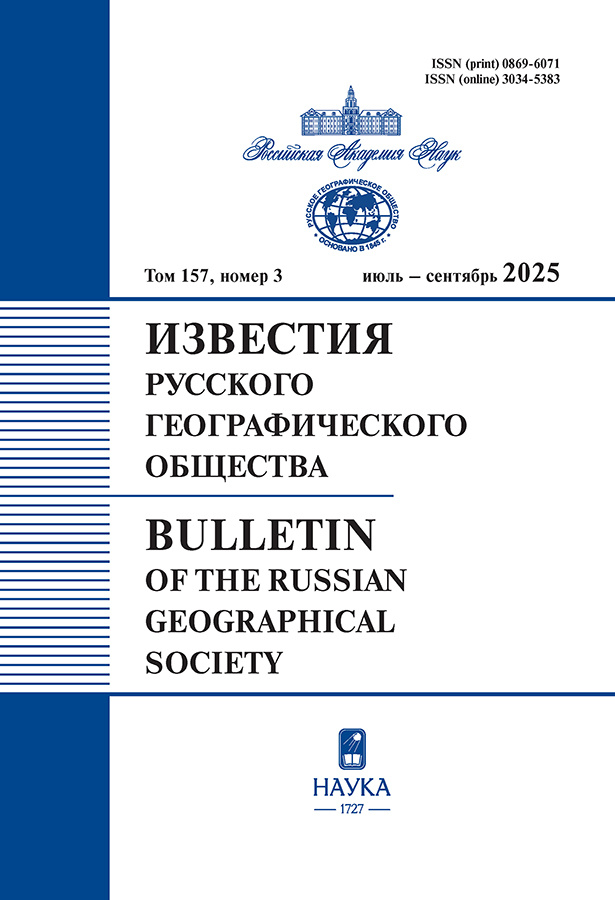Regional differences in the accumulation of produced ferrous metals stocks and scrap metal in the Russian economy
- 作者: Imangulov L.R.1
-
隶属关系:
- Lomonosov Moscow State University
- 期: 卷 157, 编号 3 (2025)
- 页面: 451-465
- 栏目: Articles
- URL: https://journals.eco-vector.com/0869-6071/article/view/691773
- DOI: https://doi.org/10.31857/S0869607125030124
- EDN: https://elibrary.ru/lubzbb
- ID: 691773
如何引用文章
全文:
详细
The article analyzes regional differences in the accumulation of ferrous metals and scrap metal stock in the Russian economy. The author’s method of assessing the metal stock of Russian regions is based on the statistical study of the regional distribution of ferrous metals in different types sectors of economic activity. The data sources are basic socio-economic indicators of the regions, the size and sectoral structure of the national ferrous metal stock. The results of the assessment revealed a significant regional variation of ferrous metal reserves. The regions of the Urals, Volga and Centre with developed industry and high population have significant reserves of ferrous metals. It was revealed that the distribution of regions by accumulation of ferrous scrap metal is not identical to their distribution in accordance with the stocks of produced ferrous metals. The distribution of regions by accumulation of ferrous scrap metal is not identical to their distribution according to stocks of produced ferrous metals. The deviations are caused by different factors. For example, in metallurgical regions, a more intensive accumulation of scrap metal is associated with the specifics of production processes in the ferrous metallurg. The results of the correlation analysis confirmed the relationship between the metal stock value in 2016 and the volumes of ferrous metal waste and scrap accumulation in 2016–2023. Regions where there is no direct correlation between the analysed indicators were found. The reasons are the peculiarities of economic development of the territories and the methodology of calculating the indicator. In conclusion, the author compared the resource base and the scale of development of scrap collection activities in Russian regions. The author identified cases of inconsistency between the number of scrap collection organisations the resource capabilities of the territories. This highlights the need for further analysis of the development of the recycling industry in conjunction with other factors.
作者简介
L. Imangulov
Lomonosov Moscow State University
Email: linar.imangulov.1999@mail.ru
Moscow, Russia
参考
- Амоша А.И., Марченко В.М., Ляшенко В.И. Особенности потенциала рынка лома черных металлов для развития металлургии России и Украины // Национальные интересы: приоритеты и безопасность. 2009. № 18. С. 55–71.
- Буданов И.А. Роль рынка металлолома в решении ресурсных проблем металлургии // Проблемы прогнозирования. 2002. № 2. С. 43–57.
- Горячко М.Д., Имангулов Л.Р. Оценка оптимальности сырьевых зон предприятий черной металлургии России в области закупок металлолома // Региональные исследования. 2022. № 2. С. 40–52. https://doi.org/10.5922/1994-5280-2022-2-4
- Зусман Л.Л. Металлический фонд народного хозяйства СССР. М.: Металлургия, 1975. 407 с.
- Козлов Г.И., Райков Ю.Н. Металлический фонд черных металлов России (методика и результаты расчетов) // Экономика в промышленности. 2013. № 2. С. 13–17.
- Мазеин Н.В. Крупнейшие ареалы черной металлургии мира: иерархия и факторы размещения // Региональные исследования. 2009. № 2. С. 59–73.
- Родионова И.А. Географические особенности проявления процессов миграции производства в металлургии мира // Вестн. РУДН. Экономика. 1999. № 1. С. 71–82.
- Структура металлофонда РФ с разделением на черный и цветной лом : интернет-портал маркетингового агентства «MegaResearch». [2008]. URL: https://www.megaresearch.ru/knowledge_library (дата обращения: 20.01.2025)
- Ткачев С.А., Гольм Д.А. Трансформация факторов территориальной организации черной металлургии в России и за рубежом // Вестник КРАГСиУ. 2014. № 13. С. 99–104.
- Угренинов С.В. Функционирование и взаимодействие региональных рынков лома и отходов черных металлов. Таганрог : Изд-во ЧОУ ВО ТИУиЭ, 2020. 96 с.
- Федеральная служба государственной статистики : федер. интернет-портал. [1999]. URL: https://rosstat.gov.ru (дата обращения: 20.01.2025)
- Хрущев А.Т. География промышленности СССР. М. : Мысль, 1986. 415 с.
- Drakonakis K., Rostkowski K., Rauch J., Graedel T.E., Gordon R.B. Metal capital sustaining a North American city: Iron and copper in New Haven, CT // Resources, Conservation and Recycling. 2007. Vol. 49. №. 4. P. 406-420. https://doi.org/10.1016/j.resconrec.2006.05.005
- Giarratani F., Gruver G., Richmond C. The US Regional Ferrous Scrap Model. In book: Trade, Networks and Hierarchies. 2002. P. 159–175.
- Graedel T.E., Reck B., Ciacci L., Passarini F. On the Spatial Dimension of the Circular Economy. Resources. 2019. № 8. P. 10. https://doi.org/10.3390/resources8010032
- Gruver G., Giarratani F. Modeling Geographic Ferrous Scrap Markets: Regional Prices and Interregional Transactions in the United States. Journal of Regional Science. 2005. № 2. P. 313–341. https://doi.org/10.1111/j.0022-4146.2005.00373.x
- Hattori R., Horie S., Hsu F., Elvidge C., Matsuno Y. Estimation of in-use steel stock for civil engineering and building using nighttime light images // Resources, Conservation and Recycling. 2013. № 83. P. 1–5. https://doi.org/10.1016/j.resconrec.2013.11.007
- Lyons D., Rice M., Wachal R. Circuits of scrap: Closed loop industrial ecosystems and the geography of US international recyclable material flows 1995–2005. The Geographical Journal. 2009. № 4. https://doi.org/10.1111/j.1475-4959.2009.00341.x
- Metal stocks in society: a scientific synthesis (2010). Report of the UN program UNEP. [Electronic resource]. Access mode: https://www.resourcepanel.org (access date: 06/11/2024)
- Pauliuk S., Wang T., Müller D.B. Steel all over the world: Estimating in-use stocks of iron for 200 countries // Resources, Conservation and Recycling. 2013. Vol. 71. P. 22-30. https://doi.org/10.1016/j.resconrec.2012.11.008
补充文件






